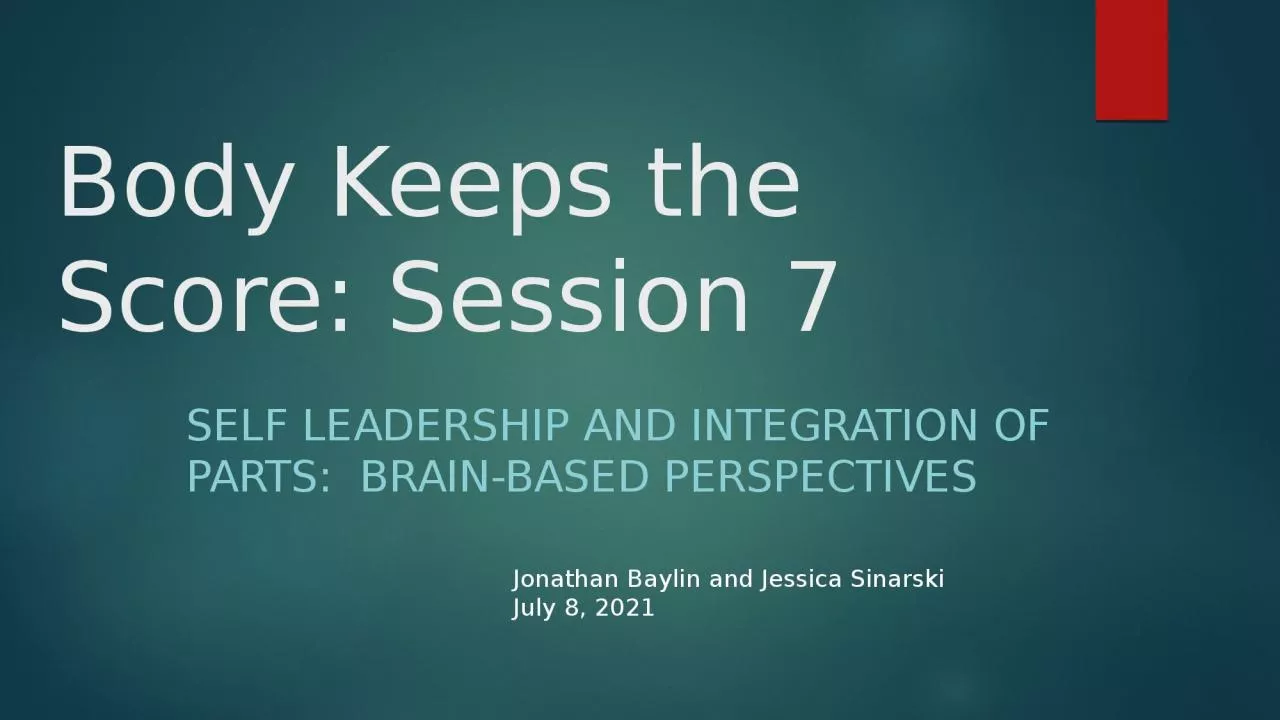

Self leadership and integration of parts brainbased perspectives Jonathan Baylin and Jessica Sinarski July 8 2021 CERTIFICATE OF ATTENDANCE attended a continuing education event on July 8 2021 from 830 am to 10 am 15 ID: 935853
Download Presentation The PPT/PDF document "Body Keeps the Score: Session 7" is the property of its rightful owner. Permission is granted to download and print the materials on this web site for personal, non-commercial use only, and to display it on your personal computer provided you do not modify the materials and that you retain all copyright notices contained in the materials. By downloading content from our website, you accept the terms of this agreement.
Slide1
Body Keeps the Score: Session 7
Self leadership and integration of parts: brain-based perspectives
Jonathan Baylin and Jessica
Sinarski
July 8, 2021
Slide2CERTIFICATE OF ATTENDANCE
attended a continuing education
event on July 8, 2021 from 8:30 am to 10 am (1.5
hrs
) via video
conference format as
Part Seven of a series entitled The Body Keeps the Score: The Neurobiology of Trauma and Healing
Presenters: Jonathan Baylin, PhD and Jessica Sinarski, LPCMH
Jonathan Baylin, PhD
coauthor, Brain Based ParentingAnd The Neurobiology of Attachment-focusedTherapy
7/8/2021
Slide3ITBT: Integrated Trauma-focused Brain-based Treatment
A neuroscience-based model for understanding and treating developmental trauma
Jonathan Baylin, PhD
June 2021
Slide4Developmentaltraumatology:
down, right, back
STAGE ONE: VERTICAL INTEGRATION
FRONTO-LIMBIC CIRCUIT
0-18 MONTHS
STAGE TWO:
HORIZONTAL INTEGRATION
LEFT AND RIGHT
INTERACTION: brain balance, non verbal and
verbal, forest and trees, feelings into words
STAGE THREE: LATERAL INTEGRATION
FRONTAL –PARIETAL CONNECTION,MATURATION
OF THE DLPFC 17-25 YEARS goal-directed
Thinking; sustained caring; “effortful control”
Of impulses;
ABILITY TO GET ABOVE “IT’S PERSONAL”
(ESSENTIAL FOR BASIC SELF-REGULATION)
TREATMENT:
UP, LEFT,
FRONT
4
Early Life Stress:
Prenatal
And postnatal
TREATMENT
C
E
B
C
C
E
E
B
B
“DISTRESS
INTOLERANCE”
SYNDROME
Slide5Key affect regulation circuit
sgACC
and amygdala:
Salience and
Affect regulation
circuit
A finding highly relevant to mood disorders is the abnormal coupling between amygdala and
sgACC
in the patients. Amygdala and rostral ACC have strong anatomical and functional connections, and their interactions are thought to mediate a functional feedback circuitry that regulates amygdala response to environmental adversity
[
Self: DMN
mPFC
Integrated, mindful,
Reflective SELF
Slide6Default Mode Network
Self Referential Thinking,
Autobiographical memory,
Reflection, theory of mind,
PAG
A
Affective
Salience:
Pos Neg
Intensity
Slide7Effects of early life stress on the DMN
7
Our findings suggest that individuals with higher early stress exposure may engage the task positive network to a greater degree that results in
suppression of the resting default network during rest.
Yin, Y.,
Jin
, C., Eyler
, L.T., Jin, H., Hu, X., Duan
, L., Zheng, H., Feng, B., Huang, X., Shan,B., Gong, Q., Li, L., 2012. Altered regional homogeneity in post-traumatic stress disorder
: a resting state functional magnetic resonance imaging study.Neurosci. Bull. 28 (5), 541–549.
UNDER DEVELOPED DEFAULTMODE NETWORK: DIMINISHEDCAPACITY FOR SELF REFLECTION,“MENTALIZATION”, THINKING ABOUT
SELF AND RELATIONSHIPS
MAKES IT HARD TO CHANGE YOUR MIND ABOUT YOURSELF AND ABOUT RELATIONSHIPS:
COGNITIVE RIGIDITY PLUS HYPERVIGILANCE FOR
POTENTIAL HARM FROM OTHER PEOPLE
Slide8ELS and
Development ofthe DMN
dmn
Developmental
Traumatology:
Neuroscience of Effects of
Early life
Chronic
Inescapable
Stress On Brain
Development
Slide9LIMBIC-DRIVEN EXPERIENCING: LOCKED ON AND EMOTING, FOR BETTER AND FOR WORSE: OBLIGATORY ATTENDING AND EMOTING
AMYGDALOID EMOTIONS
SC
PAG
AMY
Slide10The vagal shift model: Promoting
Interstate Travel from DefensiveStates Upward to Social Engagement
PAG
LC
SC
A
SC= superior colliculi
PAG= periaqueductal gray
LC= locus coeruleus
A= amygdala
Effect of direct eye contact in PTSD related to interpersonal trauma: an fMRI study of activation of an innate alarm system
Carolin
Steuwe
,
Judith K. Daniels
,
Paul A.
Frewen
,
Maria Densmore
,
Sebastian Pannasch,
Thomas Beblo, Jeffrey Reiss, Ruth A. Lanius
The Vagal Shift
Model of Treatment
For DevelopmentalTraumaSOCIAL ENGAGEMENT: VENTRAL VAGAL- PARASYMPATHETICACTIVE SELF DEFENSE: SYMPATHETIC NERVOUS SYSTEMPASSIVE SELF DEFENSE: DORSAL VAGAL- PARASYMPATHETIC
SOCIAL BUFFERING:
PACE THIS…….
EARLY LIFE
CHRONIC
STRESS
Slide11The Parasympathetic
Circuits: sgACCvs Amygdalaas the “Driver”of “downshifting”
sgACC
amygdala
Nucleus
ambiguus
:
(ventral vagal)
Nucleus of the solitary
tract
cl
Dorsal motor
vagus
Parabrachial
nucleus
PAG
Amygdala-driven
Deep downward
Shift in affect,
Heart rate activating the
Dorsal vagal circuit (unregulated
Parasympathetic response)
sgACC
-driven
Shift activating the
Ventral vagal (smart
Vagus
) circuit: regulated
Parasympathetic response
Early life adversity
=
Unregulated
Parasympathetic
Reactivity: dorsal vagal
=
Regulated parasympathetic
Activity: ventral vagal
Slide12ITBT: Integrated
Trauma-informedBrain-based Treatmentmodel
dmn
Relational
Processes:
Social buffering
Co-regulation
Story Telling
Medication
Neurofeedback:
Alpha-down
SOCIAL BUFFERING
MEDICATION
NEUROFEEDBACK
POLYVAGAL WORK
Polyvagal
Work: Interstate
Travel